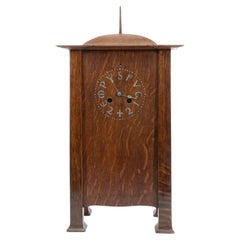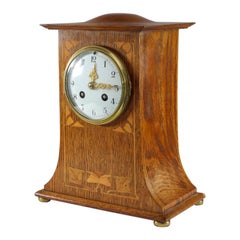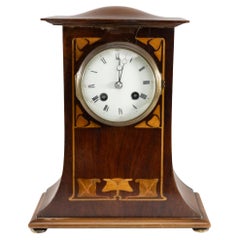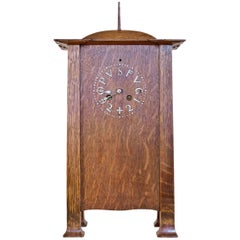Voysey Clock
Antique 19th Century British Arts and Crafts Mantel Clocks
Oak
Antique Early 1900s English Arts and Crafts Mantel Clocks
Oak
20th Century British Arts and Crafts Mantel Clocks
Mahogany
Recent Sales
Antique Early 1900s Great Britain (UK) Arts and Crafts Mantel Clocks
Pewter
People Also Browsed
Vintage 1970s French Space Age Wall Clocks
Plastic
Early 20th Century Dutch Arts and Crafts Chandeliers and Pendants
Brass
Antique Early 19th Century Russian Russian and Scandinavian Rugs
Wool
Vintage 1930s American Mid-Century Modern Table Clocks and Desk Clocks
Metal
Early 20th Century Arts and Crafts Cabinets
Oak
Vintage 1970s French Space Age Wall Clocks
Plastic
Antique 1810s Austrian Biedermeier Mantel Clocks
Maple
21st Century and Contemporary Dutch Modern Mantel Clocks
Steel
Vintage 1980s French Mantel Clocks
Brass
Vintage 1980s Italian Napoleon III Table Clocks and Desk Clocks
Sterling Silver, Enamel
Early 20th Century Czech Art Deco Table Clocks and Desk Clocks
Wood, Mahogany, Spruce, Lacquer
Vintage 1980s Italian Other Table Clocks and Desk Clocks
Velvet
Vintage 1970s Italian Queen Anne Table Clocks and Desk Clocks
Sterling Silver, Enamel, Gold, Gold Plate
Antique Early 1900s English Arts and Crafts Armchairs
Oak
Antique Early 1900s American Arts and Crafts Wall Lights and Sconces
Copper
Antique 1840s Austrian Gothic Revival Table Clocks and Desk Clocks
Granite, Steel
A Close Look at Arts-and-crafts Furniture
Emerging in reaction to industrialization and mass production, the Arts and Crafts movement celebrated handcrafted design as a part of daily life. The history of Arts and Crafts furniture has roots in 1860s England with an emphasis on natural motifs and simple flourishes like mosaics and carvings. This work is characterized by plain construction that showcases the hand of the artisan.
The earliest American Arts and Crafts furniture dates back to the start of the 20th century. Designers working in this style in the United States initially looked to ideas put forth by The Craftsman, a magazine published by Wisconsin native Gustav Stickley, a furniture maker and founder of the Craftsman style. Stickley’s furniture was practical and largely free of ornament. His Craftsman style drew on French Art Nouveau as well as the work he encountered on his travels in England. There, the leading designers of the Arts and Crafts movement included William Morris, who revived historical techniques such as embroidery and printed fabrics in his furnishings, and Charles Voysey, whose minimal approach was in contrast to the ornamentation favored in the Victorian era.
American Arts and Crafts work would come to involve a range of influences unified by an elevation of traditional craftsmanship. The furniture was often built from sturdy woods like oak and mahogany while featuring details such as inlaid metal, tooled leather and ceramic tiles. The style in the United States was led by Stickley, whose clean-lined chairs and benches showcased the grain of the wood, and furniture maker Charles Rohlfs, who was informed by international influences like East Asian and French Art Nouveau design.
Hubs in America included several utopian communities such as Rose Valley in Pennsylvania and the Byrdcliffe Arts and Crafts Colony in New York, where craftspeople made furniture that prioritized function over any decoration. Their work would influence designers and architects including Frank Lloyd Wright, who built some of the most elegant and iconic structures in the United States and likewise embraced a thoughtful use of materials in his furniture.
Find antique Arts and Crafts chairs, tables, cabinets and other authentic period furniture on 1stDibs.
Finding the Right Mantel-clocks for You
Personal time-telling devices may have migrated from our pockets to our wrists and finally onto our phones, but despite the convenience of a handheld digital timekeeper, nothing can beat well-made vintage, new and antique mantel clocks.
Invented by clockmakers in France and popularized in the 18th and 19th centuries, these practical yet ornate pieces were typically displayed on top of fireplaces or desks. While the most common mantel clocks were created in the traditional tambour style, which features a wide base that flares into an upright drum- or camelback-shaped case, modern clockmakers and furniture designers have experimented with their own ideas for these decorative objects over the years, introducing different forms and working with unconventional materials. A collection of whimsical, monochromatic handmade mantel clocks crafted by Dutch designer Kiki van Eijk, called Floating Frames, for example, features minimalist frames of anodized wire and ceramic clockfaces.
When shopping for an antique, vintage or new mantel clock, don’t be afraid to branch out. Wood mantel clocks of any era will bring a classic, elegant allure to the shelving in your living room or the bookcase in your bedroom, while Empire-style mantel clocks will comparatively boast eye-catching gilt bronze and pronounced sculptural attributes. Some Art Deco mantel clocks will feature an integration of marble or glass and will likely be marked by the decorative embellishments associated with that particular furniture style.
There’s just something about cool clocks, right? Spend your time with an extraordinary collection of mantel clocks on 1stDibs today.



